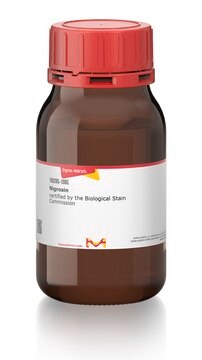1.05670
Lithium carbonate
EMPLURA®
Sinónimos:
Lithium carbonate
About This Item
Productos recomendados
Nivel de calidad
Línea del producto
EMPLURA®
Análisis
≥98.5% (acidimetric)
formulario
solid
potencia
525 mg/kg LD50, oral (Rat)
pH
10-11 (20 °C, 5 g/L in H2O)
mp
720 °C
solubilidad
13 g/L
densidad
2.1 g/cm3 at 20 °C
densidad aparente
250 kg/m3
trazas de anión
chloride (Cl-): ≤0.05%
sulfate (SO42-): ≤0.4%
trazas de catión
Ca: ≤0.05%
Fe: ≤0.003%
K: ≤0.02%
Na: ≤0.3%
heavy metals (as Pb): ≤0.005%
temp. de almacenamiento
2-30°C
InChI
1S/CH2O3.2Li/c2-1(3)4;;/h(H2,2,3,4);;/q;2*+1/p-2
Clave InChI
XGZVUEUWXADBQD-UHFFFAOYSA-L
Aplicación
- Radical Polymer-based Positive Electrodes for Dual-Ion Batteries: Describes the enhancement of battery performance through the use of γ-Butyrolactone-based electrolytes in conjunction with radical polymer-based positive electrodes, highlighting advances in lithium carbonate applications in battery technology (Rudolf K, et al., 2024).
- Analysis of Trace Impurities in Lithium Carbonate: Focuses on the precision analysis of impurities within pharmaceutical grade lithium carbonate, crucial for maintaining high purity standards in pharmaceutical applications (Suárez A, et al., 2024).
- Effects of Central Metal Ion on Binuclear Metal Phthalocyanine-Based Redox Mediator for Lithium Carbonate Decomposition: Investigates the role of central metal ions in enhancing the efficiency of lithium carbonate decomposition, important for environmental lithium analysis and recovery (Yan Q, et al., 2024).
- Selective preparation of lithium carbonate from overhaul slag by high temperature sulfuric acid roasting - Water leaching: Details a method for extracting high-purity lithium carbonate from industrial waste, demonstrating an environmentally friendly approach to lithium recovery (Dong L, et al., 2024).
- Reactive molecular dynamics simulations of lithium-ion battery electrolyte degradation: Explores the degradation mechanisms of lithium-ion battery electrolytes using simulations, contributing to the development of more durable lithium battery materials (Mabrouk Y, et al., 2024).
Nota de análisis
Identity: passes test
Chloride (Cl): ≤ 0.05 %
Sulfate (SO₄): ≤ 0.4 %
Heavy metals (as Pb): ≤ 0.005 %
Ca (Calcium): ≤ 0.05 %
Fe (Iron): ≤ 0.003 %
K (Potassium): ≤ 0.02 %
Na (Sodium): ≤ 0.3 %
Información legal
Palabra de señalización
Warning
Frases de peligro
Consejos de prudencia
Clasificaciones de peligro
Acute Tox. 4 Oral - Eye Irrit. 2
Código de clase de almacenamiento
13 - Non Combustible Solids
Clase de riesgo para el agua (WGK)
WGK 1
Punto de inflamabilidad (°F)
Not applicable
Punto de inflamabilidad (°C)
Not applicable
Certificados de análisis (COA)
Busque Certificados de análisis (COA) introduciendo el número de lote del producto. Los números de lote se encuentran en la etiqueta del producto después de las palabras «Lot» o «Batch»
¿Ya tiene este producto?
Encuentre la documentación para los productos que ha comprado recientemente en la Biblioteca de documentos.
Los clientes también vieron
Nuestro equipo de científicos tiene experiencia en todas las áreas de investigación: Ciencias de la vida, Ciencia de los materiales, Síntesis química, Cromatografía, Analítica y muchas otras.
Póngase en contacto con el Servicio técnico








